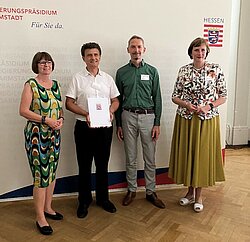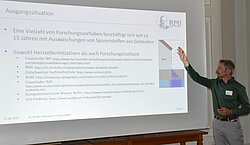Groundwater is of essential importance for man and nature. Whether as the most important resource for drinking water production, as additional irrigation in agriculture or as the basis of life for a multitude of ecosystems. Groundwater is always particularly worthy of protection. For a sustainable use of groundwater, it is therefore necessary to avoid any kind of contamination, which is why numerous institutions, initiatives and experts are working intensively on this issue
This is also the case with the Hessian Ministry for the Environment, Climate Protection, Agriculture and Consumer Protection, which developed a strategy for the avoidance and reduction of trace substance input specifically into the waters of the Hessian Marsh. The aim of this strategy is to reduce the substance load of the flowing waters in the fen by means of suitable measures and thus, in the sense of the Water Resources Act, to ensure both the diverse functions and uses of the waters in the future and to protect the groundwater resources in the fen in the long term.
As part of the "Trace Substances in the Hessian Ried" dialog forum, a competition was launched for the first time under the patronage of Hessian Environment Minister Priska Hinz, in which companies, trades, associations and institutions were invited to enter.
RMI managing director Dr. Helge Kramberger and his scientific assistant Dr. Ayman Bishara recognized the potential of one of their inventions, the "Eco-Safe" base rail filter system, sent in the necessary documents and were honored with a certificate right away. Laudator Thomas Klaßen, head of the Hesse Environmental Alliance office, was impressed. "It is an environmentally friendly and effective solution to reduce the risk of biocides and other organic chemical pollutants leaching from façade constructions being released into the soil and water bodies," Klaßen emphasized.
"Our business is facades," jokes Helge Kramberger in his presentation at the awards ceremony at the Darmstadt Regional Council, before moving on to the connection between facade paint and groundwater. "Leaching" and "biocides" are the buzzwords that have accompanied the industry for many years and have come under public criticism. The fact that so-called encapsulated biocides have been state of the art in facade coatings for around 10 years is often overlooked. These are microcapsules that ensure that the active ingredients remain better bound in the surface. Due to the encapsulation, the release is significantly delayed. As a result, the active ingredient remains in the coating film much longer and much lower input concentrations are required to provide significantly longer protection against algae and fungal attack on the facade.
A large number of research projects, in which the RMI is also involved, have been dealing with the leaching of trace substances from buildings for around 15 years now. Kramberger only draws comparisons with the many times higher levels of pollution caused by pesticides in passing, but he emphasizes the responsibility to the environment and the precautionary principle: "We must and will do our part, even with the smallest quantities."
In this context, Kramberger also points to the variety of products offered by construction paint manufacturers: For a facade coating, there are both various biocide-containing and biocide-free products available. The decision is ultimately made by the client of the construction project.
But does one have to accept the residual risk of small amounts of trace substances? No, is the clear answer from Helge Kramberger. As complicated as the name "Eco-Safe" base rail filter system may sound, the principle is simple: full technical protection and durability for the facade while avoiding the release of trace substances.
"The rails are intended for different design options and materials," says Helge Kramberger, adding, "They are perfectly suited both for retrofitting during renovation painting and for reuse in another construction project, so they are a perfect solution for painting contractors. They can easily remove rails once they have been installed on the house wall after two to three years, when the release of active substances approaches zero, replace the filter material and install it on a new facade. It couldn't be easier to protect the environment."
The patent application has been filed, and the first pilot projects have already been implemented in cooperation with an innovative painting company. But Kramberger would like to see more: further pilot projects and signals to the industry to generate market interest and go into series production.
According to Environment Minister Prisca Hinz, he does not have to worry about this and promises to duly place this innovation in her talks with colleagues in the Hessian Ministry of Economics, who are responsible for construction.




